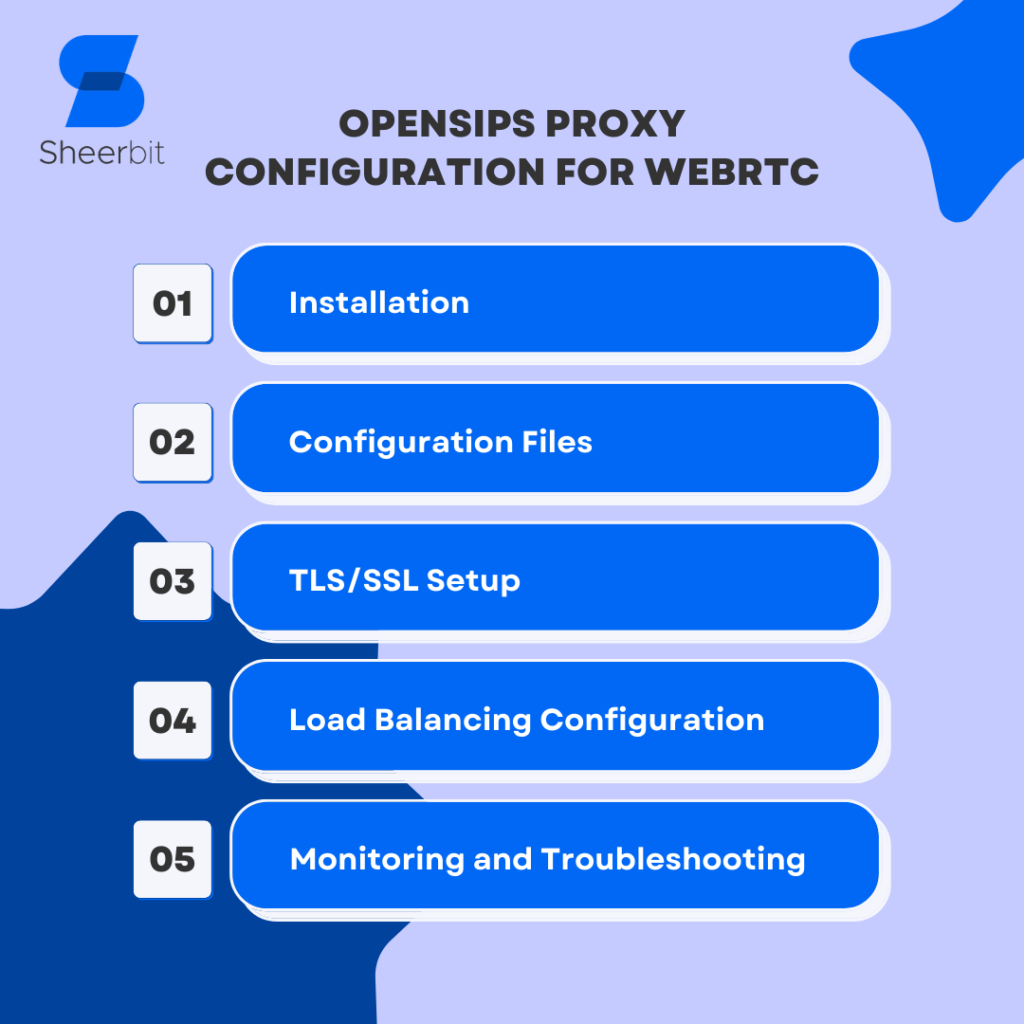The real-time communication landscape has drastically changed with the release of the WebRTC (Web Real-Time Communication) protocol. It is noteworthy since it is the only program that could provide seamless web browser communication without needing other plugins or applications. This ground-breaking technology has become widely used and is now indispensable for various applications, from video conferencing systems connecting people worldwide to online gaming, where quick communication is critical. Because WebRTC is so user-friendly and accessible, it is an essential component of modern online interactions.
However, more than mastering the WebRTC protocol alone is insufficient to guarantee optimal performance and successfully negotiate its complexity. Additional knowledge is required. At this point, the OpenSIPS Proxy turns into a crucial component. One robust and adaptable solution that forms the basis of the WebRTC ecosystem is OpenSIPS Proxy, which solves scalability, load balancing, security, and interoperability problems. Including OpenSIPS Proxy in your infrastructure turns it into a strategic need rather than an option if you want to succeed in the competitive and fast-paced WebRTC market. This will increase your chat service’s efficacy and customer satisfaction to previously unheard-of heights.
Understanding the WebRTC Landscape
WebRTC has come to be linked with low-latency communication, enabling users to hold real-time discussions directly from their browsers. Because it eliminates the need for third-party plugins or apps, this strategy is a favorite among developers looking to enhance the user experience in their online programs.
WebRTC allows users to transmit data, video, and audio without relying on centralized servers using a peer-to-peer communication protocol. Although this approach is faster and more effective, there are also certain disadvantages, especially scalability and security management.
The Role of OpenSIPS Proxy
The role that OpenSIPS Proxy, an open-source SIP (Session Initiation Protocol) proxy server, plays in optimizing WebRTC communication is now vital to discuss. It acts as a go-between, managing traffic routing and signaling efficiently.
Key Features of OpenSIPS Proxy:
1. Scalability:
OpenSIPS Proxy stands out when it comes to managing large-scale WebRTC installations. Your chat application can handle a growing user base without compromising functionality because of the straightforward scalability provided by its modular design.
2. Load Balancing:
OpenSIPS Proxy ensures a smooth and speedy user experience by distributing incoming traffic among several servers, preventing bottlenecks. This holds great significance in WebRTC applications where minimal latency is essential.
3. Security:
Security has to be the top priority for any system allowing real-time communication. OpenSIPS Proxy offers robust security features like encryption and authentication to safeguard your communication routes from outside threats.
4. Interoperability:
Given its wide variety of protocol compatibility, OpenSIPS Proxy offers excellent flexibility. Whether your application employs WebSocket, SIP, or other communication protocols, its Proxy can integrate and provide seamless connectivity effortlessly.

OpenSIPS Proxy Configuration for WebRTC
Correct setup is essential to use OpenSIPS Proxy’s full potential in your WebRTC application. Here are some crucial actions to think about:
1. Installation:
Install OpenSIPS Proxy first on your server. Comprehensive instructions for various operating systems are provided in the official literature.
2. Configuration Files:
Make necessary adjustments to OpenSIPS configuration files to support your WebRTC application. Watch for SIP routing characteristics, security, and load balancing.
3. TLS/SSL Setup:
Use Secure Sockets Layer (SSL) or Transport Layer Security (TLS) to encrypt user communications. This is a crucial step in protecting the confidentiality and integrity of transmitted data.
4. Load Balancing Configuration:
To ensure that traffic is split equally across several servers, optimise the load balancing settings. This is crucial, especially in cases of high traffic, to prevent server congestion and deliver an ideal user experience.
5. Monitoring and Troubleshooting:
Utilise monitoring tools to monitor for any issues and manage server performance. The logging features that OpenSIPS Proxy offers can be beneficial in diagnosing and addressing problems.
Case Study: Elevating Chat Applications with OpenSIPS Proxy
Let’s look at a case study of a chat platform that effectively used it to show how this solution affects WebRTC apps.
The Challenge:
As its user base increased, a well-known chat programme required assistance with performance. Users were experiencing delays in getting their messages during peak usage hours, and the existing infrastructure aid was needed to handle the growing traffic volume.
The Solution:
The development team used OpenSIPS Proxy to address speed and scalability concerns. By configuring OpenSIPS Proxy for load balancing and optimizing SIP routing, the program was able to achieve the following results:
1. Improved Latency:
By employing OpenSIPS Proxy to control traffic distribution, the chat program achieved substantially reduced latency and provided real-time communication even during periods of high demand.
2. Enhanced Scalability:
Because of OpenSIPS Proxy’s modular architecture, the chat platform could quickly expand its infrastructure to handle an increasing user population without sacrificing performance.
3. Secured Communication:
By using OpenSIPS Proxy to implement TLS, user communication was kept private and secure from potential security risks.
4. Reliable Performance:
With monitoring tools integrated with OpenSIPS Proxy, the development team proactively identified and addressed performance issues, resulting in a more stable and reliable chat application.
Conclusion
Making wise infrastructure selections is necessary to succeed in the dynamic WebRTC ecosystem. OpenSIPS Proxy is a powerful ally that provides the tools needed to optimize performance, ensure security, and facilitate seamless communication in WebRTC applications.
To upgrade your conversation game, consider integrating OpenSIPS Proxy into your system. It is a desirable alternative for developers who wish to offer a better WebRTC experience because of its load balancing, security, compatibility, and scalability benefits.
Will your chat program make the most of WebRTC to the fullest? Start down the path to greatness by becoming proficient with it. To learn more about integrating it’s Proxy into your WebRTC setup easily, contact us for comprehensive guidance, support, and tutorials. Raise the ante in your chat room and provide your users with the best real-time dialogue possible!





